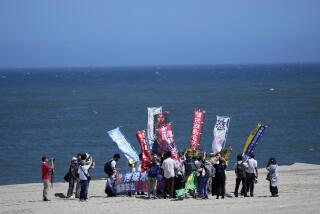Japan’s prime minister criticizes nuclear plant’s owner
- Share via
Japanese Prime Minister Naoto Kan for the first time criticized Tepco, which owns the Fukushima Daiichi nuclear power plant, for inadequate preparations for a tsunami at the facility. The sea wall at the plant was designed to withstand an 18-foot wave, while the actual tsunami that struck after the magnitude 9 Tohoku earthquake was estimated to be more than 40 feet high.
“It’s undeniable their assumptions about tsunamis were greatly mistaken,” Kan said Tuesday of the Tokyo Electric Power Co. in an address to the Japanese parliament. “The fact that their standards were too low invited the current situation.”
Kan also criticized the company for placing the backup diesel generators, which were to provide power to the emergency cooling system, in the basements of reactor buildings, where they were swamped by seawater and disabled.
U.S. officials said Tuesday that engineers at the plant seem to be making a “slow recovery” from the earthquake and the accompanying tsunami that severely disabled the plant earlier this month.
“However, the long-term cooling of the reactor and the pools is essential during this period and has not been adequately restored to date, to the best of my knowledge,” Peter Lyons, head of the U.S. Department of Energy’s Office of Nuclear Energy told a Senate committee.
Lyons also said the discovery of plutonium in the soil at the reactor site should not be surprising. “All operating reactors … build up plutonium during the course of operation, so finding plutonium that is derived in the operating reactors or the spent fuel pools would not be regarded as a major surprise.”
He added that it would be a concern if the plutonium were present in high levels, but so far it has been detected only in trace amounts that are consistent with deposits from nuclear testing abroad.
In separate testimony to the committee, Bill Borchardt, executive director for operations at the U.S. Nuclear Regulatory Commission, echoed Lyons’ sentiments, noting that the situation at the nuclear plant “continues to further stabilize.”
At the plant, meanwhile, workers were piling sandbags at the ends of tunnels near the coast as water levels inside the tunnels rose and threatened to spill out into the ocean. The water is highly radioactive and international law forbids its release into the sea, although the radiation would most likely be dispersed to the point where it was inconsequential.
Experts fear it could damage ocean life in the immediate vicinity of the plant, however.
Engineers are attempting to pump water out of the tunnels to restore access to the areas where workers have been attempting to restore power to the stricken facility, but are running out of places to store the radioactive water until its radiation levels can decay.
According to the Tokyo Electric Power Co., which owns the facility, minor progress was being made Tuesday at the site. At reactor No. 1, water injection was now being handled by a portable pump rather than a fire engine, the company said.
At reactor No. 3, engineers had begun injecting fresh water into the reactor, replacing the seawater that had been used since the crisis began. And at reactor No. 4, lights were restored in the control room.
Two workers at the plant were drenched with radioactive water Tuesday, but their protective suits apparently served their function and no radiation was detected on the workers’ bodies.
Times wire services contributed to this report.
More to Read
Sign up for Essential California
The most important California stories and recommendations in your inbox every morning.
You may occasionally receive promotional content from the Los Angeles Times.










